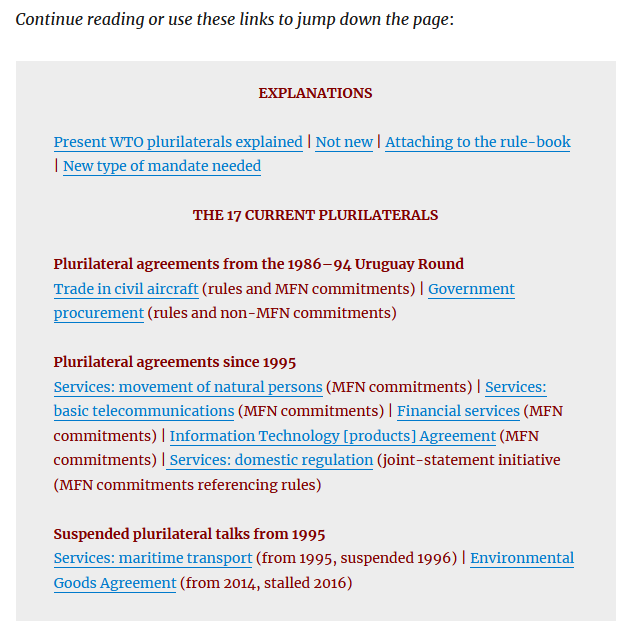
A New Year gift for Trade Twitter
Work in the @wto is increasingly “plurilateral” = among part of the membership (“multilateral” = the whole membership)
Is it the way to go when WTO-wide consensus is elusive?
It’s controversial. There are pitfalls
1/7 tradebetablog.wordpress.com/2022/01/03/17-…
Work in the @wto is increasingly “plurilateral” = among part of the membership (“multilateral” = the whole membership)
Is it the way to go when WTO-wide consensus is elusive?
It’s controversial. There are pitfalls
1/7 tradebetablog.wordpress.com/2022/01/03/17-…
This is an attempt to explain plurilaterals. It’s in 2 parts:
• General explanation, including political and legal pitfalls
• The plurilaterals, each in a nutshell. There are 17, so I’m afraid it’s long, from e-commerce to environment and trade
2/7 tradebetablog.wordpress.com/2022/01/03/17-…
• General explanation, including political and legal pitfalls
• The plurilaterals, each in a nutshell. There are 17, so I’m afraid it’s long, from e-commerce to environment and trade
2/7 tradebetablog.wordpress.com/2022/01/03/17-…
Plurilaterals are not new. They date back at least to the 1960s and 1970s under the pre-WTO GATT.
5 are now fully multilateral WTO agreements
2 are still plurilateral
2 have been scrapped
3/7 tradebetablog.wordpress.com/2022/01/03/17-…
5 are now fully multilateral WTO agreements
2 are still plurilateral
2 have been scrapped
3/7 tradebetablog.wordpress.com/2022/01/03/17-…

5 (or 6 depending on how we count) plurilaterals have been concluded under the WTO (since 1995)
2 negotiations have been suspended
4/7 tradebetablog.wordpress.com/2022/01/03/17-…
2 negotiations have been suspended
4/7 tradebetablog.wordpress.com/2022/01/03/17-…

7 plurilaterals are currently under discussion in the WTO. Some are proper negotiations. Others are just talk (for now at least). The aim is to modernise the @wto.
1 is procedural: on appealing dispute rulings while the Appellate Body cannot function
5/7 tradebetablog.wordpress.com/2022/01/03/17-…
1 is procedural: on appealing dispute rulings while the Appellate Body cannot function
5/7 tradebetablog.wordpress.com/2022/01/03/17-…

The legal and political pitfalls are about whether the plurilaterals discriminate against non-participating WTO members, how that is inserted into the WTO rule-book, and whether dissenting countries can block making the results legal. It’s complicated
6/7 tradebetablog.wordpress.com/2022/01/03/17-…
6/7 tradebetablog.wordpress.com/2022/01/03/17-…

That explanation is long, but for even more information on most of the plurilaterals, go to Geneva Trade Platform’s excellent website
7/7 wtoplurilaterals.info
7/7 wtoplurilaterals.info
• • •
Missing some Tweet in this thread? You can try to
force a refresh














